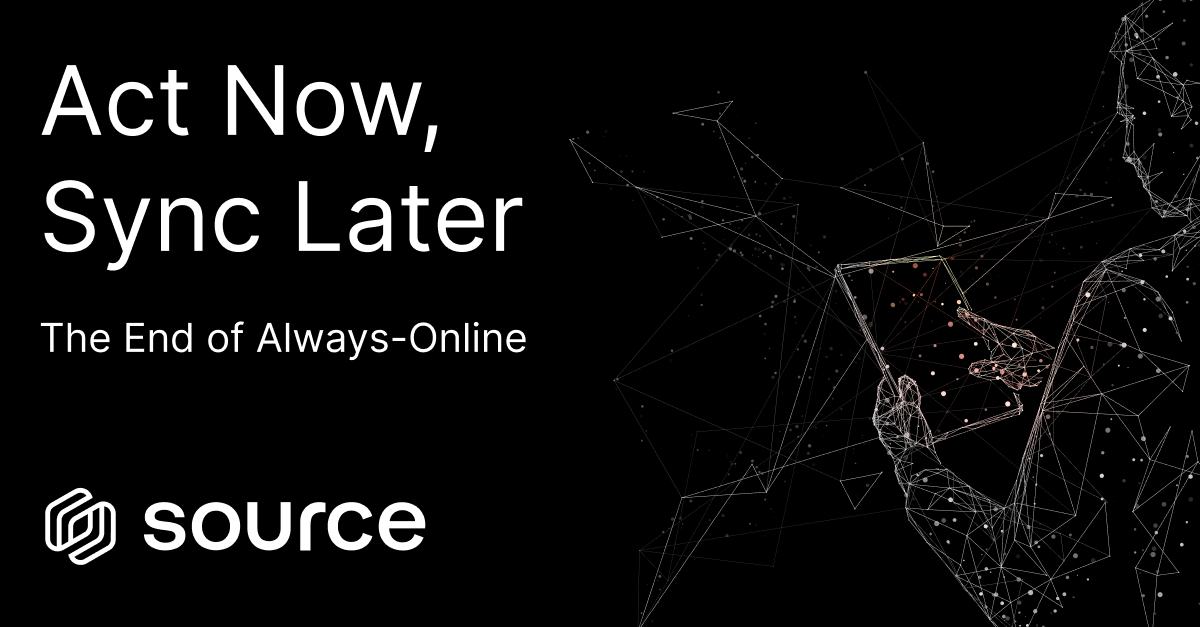It’s good to talk. When, how, and why is the language of getting anything done. Whether it’s meeting a friend at the bar or building a starship, you’ve got to stay in sync. Syncing is just communication. Building a foundation of data to make your next decision. “What happened? What’s changed since the last time we spoke?” In computer systems, it’s the same. Whether it be a mobile app checking in with a server, a warehouse updating a supply chain dashboard, or two databases working in tandem to power an energy grid. It’s just talking - and talking is hard.
Sync or Swim
It’s time sink, pun partially intended. Developers spend extraordinary amounts of time ensuring their app stays in sync with the rest of the digital universe. Two decades of legacy systems have been built by pioneer software developers all attempting to answer the simple problem of how do we ensure the data we have matches the data others have so that we can all make the right decisions. We’ve treated sync as the cornerstone of how distributed applications work. If your software application runs on many devices, then they all need to stay in agreement.
So we built for it. Layer upon layer over years and years. We poll APIs continuously and burn bandwidth. We issue webhooks that fail silently unless carefully monitored. We establish gorgeous ETL pipelines on our infra, only to watch them break as the schema drifts. We can fastidiously stamp everything with timestamps, version history and event IDs, and still face mismatched ordering problems due to retries, lag, the curvature of the earth, and physics itself. All these potential errors happen constantly, and the central auditing system is left trying to pick up the pieces with giant conflict resolution queues as data awaits processing.
Any slight network outage can lead to an error, and any slight error can lead to an outage. It’s a constant patchwork effort of communication and, with our current structures, the make do and mending never stops. The cloud has been incredible at simplifying syncing across distributed applications, but it means sync assumes the cloud is always reachable. Infrastructure freezes, stalls, forks, and sometimes breaks permanently when network connections are lost - even if no one is at fault. Stuff just happens. That’s annoying for a retailer trying to order a product, dangerous for financiers moving money, devastating for a farmer managing their crops, and fatal for hospitals caring for their patients.
The Move Towards the Edge
This, then, is driving the movement towards Edge-native systems. Cloud providers like Google and AWS already understand the limitations of their models, regardless of how groundbreaking it was for the internet then and how profitable it is for them now. Syncing as it exists will simply never be perfect. Keeping data up to date through central management and auditing will always be a recursively imploding system of compounding errors. It will always be about minimizing mistakes instead of maximizing potential.
What if we just remove the need to sync? What if our devices and applications can work autonomously without the internet? A modern irrigation controller in a rural area that loses signal due to inclement weather doesn’t suddenly stop watering the crops, or a warehouse losing WiFi still able to scan shipments and send things out promptly. Truly autonomous and connected systems that sustain themselves. That’s the true power of proper data management. In our current model, these things break. Same does your music app, GPS, or even medical sensors. This is because the data that fuels these applications cannot be operated without the support of the cloud infrastructure. No cloud, no service.
Sync Your Data Into This
Instead of needing to sync to work, what if devices just needed a catch up every now and again to continue to be operational? You don’t talk to your friend everyday, but you need to talk to them every month. Edge-native infrastructure like Source Network is built to be there when the cloud can’t, and make things work in places the cloud can’t reach - like up above the stars in our satellite arrays. By ensuring every device can act, process data, authorize actions and validate state changes locally - at least for a crucial period of time. Then when the network comes back, sync happens. A catch up on the events of the day.
Source Network removes sync as a bottleneck by providing a frictionless data management stack for edge compute environments. DefraDB is a local database that can read, write and update even without the internet, before publishing those updates with its peers (devices, servers, other apps) to sync up. While LensVM’s bi-directional data transformation eliminates breaks when syncing data. It translates those schema variations between devices and environments to ensure a uniform format - without having to write bespoke coding fullers and ETL pipelines across every new device in a network. Source Network’s stack lays foundations for developers to help them orchestrate device fleets in challenging edge environments.
Furthermore, data is imbued with its own permission and access controls written into the data types. The operations taking place on that data are logged cryptographically by SourceHub, where data owners can define their permissions policies and what their data can be used for. A device can know what it’s allowed to do even when it’s offline. Whether it’s watering crops, sending shipments or saving lives. Sync used to mean central authority, seeking permissions, reconciliation purgatory, and loss of privacy. Now it means peer-to-peer convergence, regular catch ups, and autonomy to achieve our goals, just like it does between humans.
Catching Up
Of course, tearing out 20 years of legacy systems and switching to an entire new data management model is both conceptually and practically difficult, even as edge-native initiatives gather steam. But that’s the point, Source Network is not about ripping out or shutting down the cloud. It’s about birthing a new foundational model right underneath it that synergises and complements cloud infrastructure - making both better, and helping both deliver choice, control and privacy to developers, end users, and organizations.
Yet with sovereign data, in a very real way, that utopian benefit is just a side product of what Source Network actually achieves - building a new data management model that, by banishing the need for always online, creates globally resilient civilizational computer systems that serve us all. Better sanitation, better healthcare, better transportation, better factories, better spaceships.
 Source Team
Source Team

